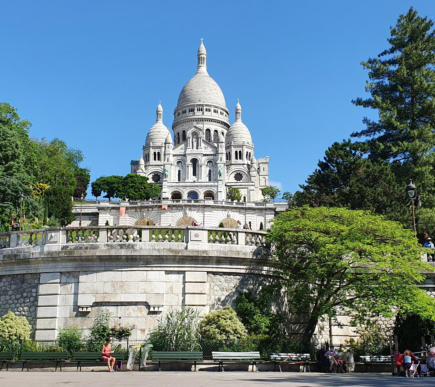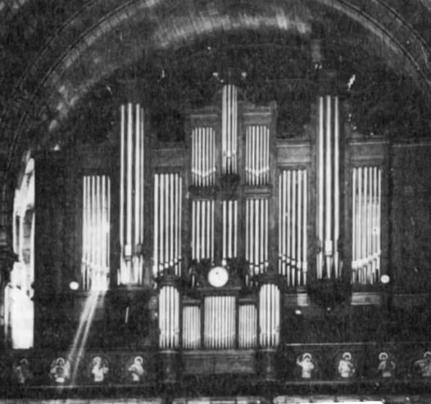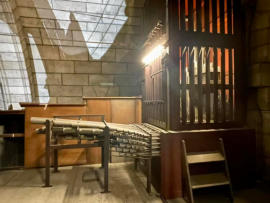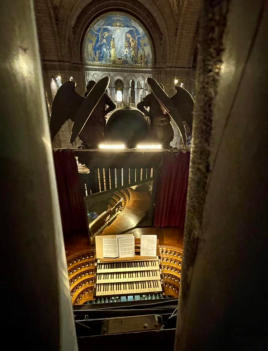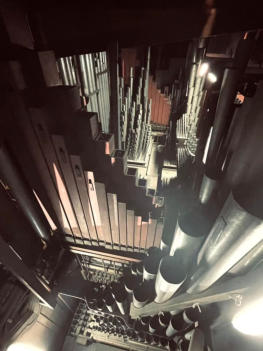


ORGANS OF PARIS © 2024 Vincent Hildebrandt HOME ALL ORGANS

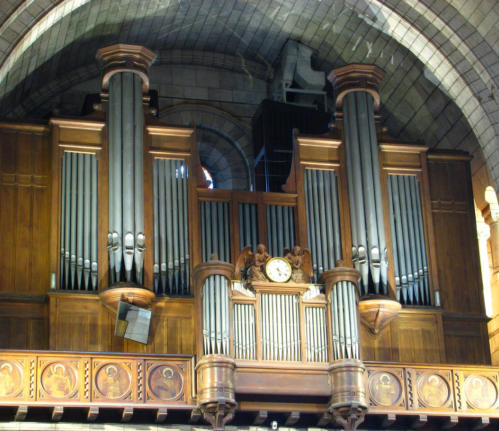
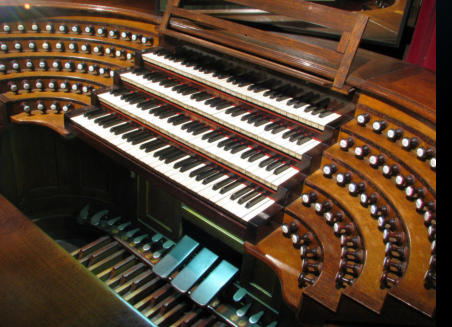

The Sacré-Cœur Basilica is an immense basilica in a
Roman-Byzantyne style, built as a national penance for
the defeat of France in the 1871 Franco-Prussian War
and the socialist Paris Commune of 1871. Construction
of the Basilica started in 1876 with Abadie as the
leading architect. When Paul Abadie died in 1884, he
was succeeded by Lucien Magne, who added an 83
meter (272 ft) tall clock tower. The Savoyarde clock
installed here is one of the world's largest.
Construction was finished in 1914 and it was
consecrated after the end of World War I in 1919.

C1
Baron Albert de l'Espée, who already owned two large Cavaillé-
Coll organs, ordered an organ for 100,000 francs to occupy a
gigantic room in his 20,000 m2 Ibarritz castle in the Basque
Country (south of Biarritz). The huge organ hall was 22 meters
long, 14 meters wide and 17 meters high. The organ built for
this occasion by Cavaillé-Coll was a copy of his best concert
organ located in the hall of the Albert Hall in Sheffield since
1873.
The 1898 instrument featured 70 stops on four keyboards (61
notes) and a 32-note pedalboard. This organ of 70 stops was
the third, in order of magnitude, in the production of Cavaillé-
Coll after Saint-Sulpice (1862) and Notre-Dame (1868) and the
largest private organ of France!
The amphitheatrical console included the drawing of the
double-acting stops and air motors drove the transmissions.
The expression concerned three divisions out of 4, the range of
61 notes to the keyboards, chorus of reeds 16', 8', 4' in
chamade at high pressure, to the Solo, hidden behind the
buffet and three 32' to the pedal and three sets of undulating
stops.
In 1903, the baron wanting to sell his castle, sold his organ to
Charles Mutin for an unknown price. The organ was unfinished
at the time of the transfer since it remained to manufacture 14
stops of reeds, and perform the harmony of the organ. Mutin
reassembled the organ in his workshops, where it was played
by the most famous organists of the time - including Albert
Schweitzer - and where he remained until 1913. The plan
remained unchanged, but Mutin made some modifications to
the composition probably intended to make the organ less
"orchestral", seeking in particular to remedy the poverty in
Mutations and Mixtures that characterized it, in the face of the
abundance of foundations and reeds of 16' and 8'.
The organ was transferred to the Sacré-Cœur in 1914 where it
was housed in the case of the architect Lucien Magne.
Mutin added several registers:
•
Grand-orgue : Doublette 2’, Nazard 2 2/ 3’
•
Positif : Cromorne 8’
•
Récit : Plein Jeu 5 rangs.
He discards 11 stops replaced as follows:
•
Pedal: Quintaton 16' replaced by Quinte 2 2/3'; Bassons 8
and 4 replaced by Tierce 6 2/(éme and Septième 4 4/7',
which allows, with the Flutes 32,18,8,4 ' and the mutations
to obtain a Cornet decomposed of 8 ranks of 32'.
•
Positive: Cor Anglais replaced by Bassoon
•
Récit: Viole d'amour 4', Clarinets 16 and 8 replaced by
Diapason 8' and Clairon 4'.
•
Solo: Clarinet 16', Cromorne 8', Clairon 4' replaced by Viole
de Gambe 8', Musette 8’ and large 8-rank Cornet. In
chamade, the 8' Basson-Hautbois is replaced by the 16' Tuba
Magna.
The instrument was inaugurated by Marcel Dupré, Abel Decaux
and CM Widor in October 1919.
Several modifications took place in 1930-1931 by the Société
Cavaillé-Coll:
•
addition of a Doublette 2 to the Pedal;
•
replacement of Basson 16 of the Récit by a Bombarde, of
the Musette of the Solo by a Nasard.
An overhaul took place in 1948 by Jean Perroux, who removed
the three high ranks of the Cornet V of the Solo.
In 1959, a restoration was undertaken by the Beuchet-Debierre
house:
•
at the Grand-Orgue: transformation of the Flûte
harmonique 4 into a Flûte douce, of Violin 8 into Salicet 4.
•
Positive: transformation of Salicional into Unda Maris,
Octavin into Doublette; addition of a Cymbal IV ranks.
•
to the Swqell: replacement of the Octavin by a Flageolet 2,
addition of a Principal 4, recomposition of the Plein-jeu.
•
Solo: addition of a Bourdon 8 and a Tierce 1 3/5, removal of
the Tremolo.
On this occasion, the harmonization of certain stops was
modified (removal of many teeth) and the central part of the
case was removed, made at the request of the clergy who
wished to clear the glass roof placed at the back of the organ.
As a result, the corresponding pipes of the Montre had to be
moved and the expressive box of the Solo had to be separated
into two parts. It is thanks to the intervention of Marcel Dupré
that the organ was not electrified.
The latest restoration dates from 1985, and was carried out by
Jean Renaud de Nantes, who restored the symphonic character
of the organ by removing the additions of 1959 in favor of stops
which are more in line with the aesthetics of ACC. Thus, the
Cymbal of the Positive was replaced by a progressive Cornet,
the Basson 8 of Mutin was transformed into Basson 16, the
Plein-Jeu of the Récit was recomposed (with resultant of 16), the
Principal 4 was replaced by an Octave 4, the three high ranks of
the Cornet of the Solo were restored and the expressive box of
the Solo was reconstructed.
In 2013, a restoration of the main wind tunnel, located in the
attic of the basilica, was carried out by Muhleisen.
About 70% of the pipes are from Cavaillé-Coll.
Sources:
facebook.com/aristidecavaillecoll
Orgues de l'Ile-de-France
orgues-et-vitraux.ch
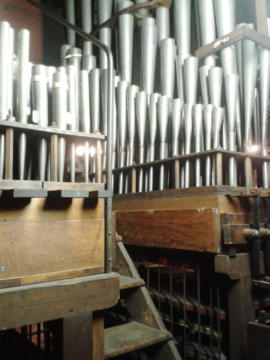
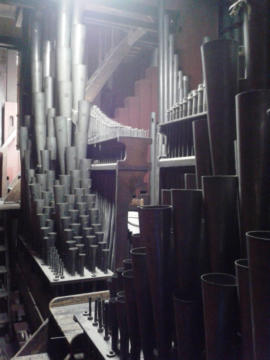
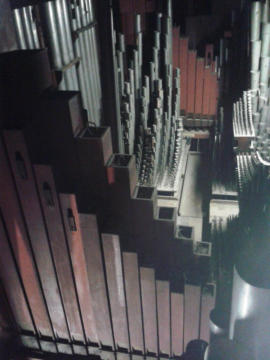
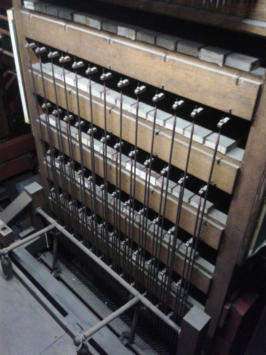
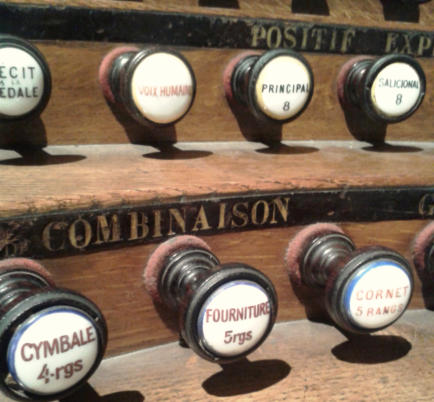
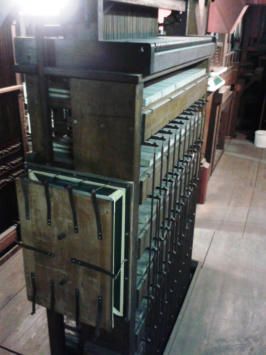
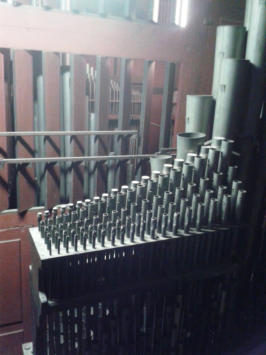
Organiste titulaire
Claudine Barthel, Philippe Brandeis, Gabriel Marghieri.
Famous organists in the past: Rolande Falcinelli, Daniel
Roth, Naji Hakim.
Concerts
Only on Christmas Eve 10PM
Masses with organ
Friday 3PM; sunday 11AM, 6PM, 10PM, vespers 4PM
Videos
Philippe Brandeis (2017)
Daniel Roth (1980)
Photos GO/console: Pierre Marteau
Photos interior: Victor Weller
1898 - Cavaillé-Coll (1)
1919 - Mutin (5)
1931 - Cavaillé-Coll (6)
1948 - Jean Perroux (6)
1959 - Beuchet-Debierre (3a)
1985 - Renaud (4)
2003 - Dargassies (6)
2013 - Muhleisen (6)
IV/79 - traction mécanique
Composition
The organs of Paris
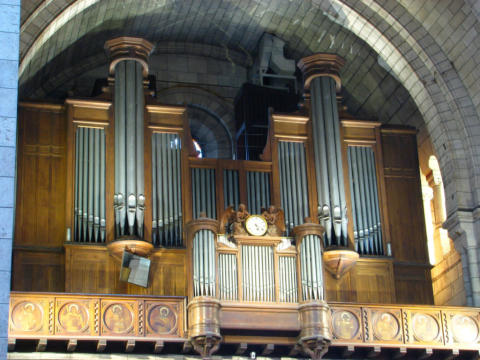
ORGANS OF PARIS © 2024 Vincent Hildebrandt ALL ORGANS
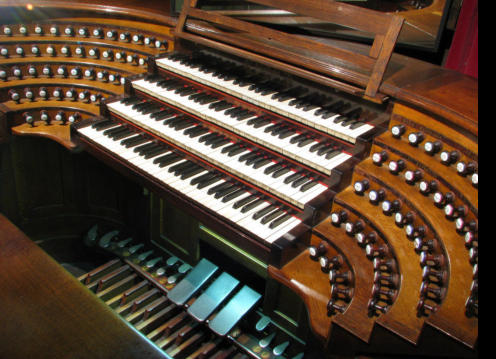
C1
Baron Albert de l'Espée, who already owned two large
Cavaillé-Coll organs, ordered an organ for 100,000 francs to
occupy a gigantic room in his 20,000 m2 Ibarritz castle in the
Basque Country (south of Biarritz). The huge organ hall was
22 meters long, 14 meters wide and 17 meters high. The
organ built for this occasion by Cavaillé-Coll was a copy of his
best concert organ located in the hall of the Albert Hall in
Sheffield since 1873.
The 1898 instrument featured 70 stops on four keyboards (61
notes) and a 32-note pedalboard. This organ of 70 stops was
the third, in order of magnitude, in the production of Cavaillé-
Coll after Saint-Sulpice (1862) and Notre-Dame (1868) and the
largest private organ of France!
The amphitheatrical console included the drawing of the
double-acting stops and air motors drove the transmissions.
The expression concerned three divisions out of 4, the range
of 61 notes to the keyboards, chorus of reeds 16', 8', 4' in
chamade at high pressure, to the Solo, hidden behind the
buffet and three 32' to the pedal and three sets of undulating
stops.
In 1903, the baron wanting to sell his castle, sold his organ to
Charles Mutin for an unknown price. The organ was
unfinished at the time of the transfer since it remained to
manufacture 14 stops of reeds, and perform the harmony of
the organ. Mutin reassembled the organ in his workshops,
where it was played by the most famous organists of the time
- including Albert Schweitzer - and where he remained until
1913. The plan remained unchanged, but Mutin made some
modifications to the composition probably intended to make
the organ less "orchestral", seeking in particular to remedy
the poverty in Mutations and Mixtures that characterized it, in
the face of the abundance of foundations and reeds of 16'
and 8'.
The organ was transferred to the Sacré-Cœur in 1914 where it
was housed in the case of the architect Lucien Magne.
Mutin added several registers:
•
Grand-orgue : Doublette 2’, Nazard 2 2/ 3’
•
Positif : Cromorne 8’
•
Récit : Plein Jeu 5 rangs.
He discards 11 stops replaced as follows:
•
Pedal: Quintaton 16' replaced by Quinte 2 2/3'; Bassons 8
and 4 replaced by Tierce 6 2/(éme and Septième 4 4/7',
which allows, with the Flutes 32,18,8,4 ' and the mutations
to obtain a Cornet decomposed of 8 ranks of 32'.
•
Positive: Cor Anglais replaced by Bassoon
•
Récit: Viole d'amour 4', Clarinets 16 and 8 replaced by
Diapason 8' and Clairon 4'.
•
Solo: Clarinet 16', Cromorne 8', Clairon 4' replaced by Viole
de Gambe 8', Musette 8’ and large 8-rank Cornet. In
chamade, the 8' Basson-Hautbois is replaced by the 16'
Tuba Magna.
The instrument was inaugurated by Marcel Dupré, Abel
Decaux and CM Widor in October 1919.
Several modifications took place in 1930-1931 by the Société
Cavaillé-Coll:
•
addition of a Doublette 2 to the Pedal;
•
replacement of Basson 16 of the Récit by a Bombarde, of
the Musette of the Solo by a Nasard.
An overhaul took place in 1948 by Jean Perroux, who
removed the three high ranks of the Cornet V of the Solo.
In 1959, a restoration was undertaken by the Beuchet-
Debierre house:
•
at the Grand-Orgue: transformation of the Flûte
harmonique 4 into a Flûte douce, of Violin 8 into Salicet 4.
•
Positive: transformation of Salicional into Unda Maris,
Octavin into Doublette; addition of a Cymbal IV ranks.
•
to the Swqell: replacement of the Octavin by a Flageolet 2,
addition of a Principal 4, recomposition of the Plein-jeu.
•
Solo: addition of a Bourdon 8 and a Tierce 1 3/5, removal
of the Tremolo.
On this occasion, the harmonization of certain stops was
modified (removal of many teeth) and the central part of the
case was removed, made at the request of the clergy who
wished to clear the glass roof placed at the back of the organ.
As a result, the corresponding pipes of the Montre had to be
moved and the expressive box of the Solo had to be
separated into two parts. It is thanks to the intervention of
Marcel Dupré that the organ was not electrified.
The latest restoration dates from 1985, and was carried out
by Jean Renaud de Nantes, who restored the symphonic
character of the organ by removing the additions of 1959 in
favor of stops which are more in line with the aesthetics of
ACC. Thus, the Cymbal of the Positive was replaced by a
progressive Cornet, the Basson 8 of Mutin was transformed
into Basson 16, the Plein-Jeu of the Récit was recomposed
(with resultant of 16), the Principal 4 was replaced by an
Octave 4, the three high ranks of the Cornet of the Solo were
restored and the expressive box of the Solo was
reconstructed.
In 2013, a restoration of the main wind tunnel, located in the
attic of the basilica, was carried out by Muhleisen.
About 70% of the pipes are from Cavaillé-Coll.
Sources:
facebook.com/aristidecavaillecoll
Orgues de l'Ile-de-France
orgues-et-vitraux.ch
Organiste titulaire
Claudine Barthel, Philippe Brandeis, Gabriel Marghieri.
Famous organists in the past: Rolande Falcinelli, Daniel Roth,
Naji Hakim.
Concerts
Only on Christmas Eve 10PM
Masses with organ
Friday 3PM; sunday 11AM, 6PM, 10PM, vespers 4PM
Videos
Philippe Brandeis (2017)
Daniel Roth (1980)
Photos GO/console: Pierre Marteau
Photos interior: Victor Weller





